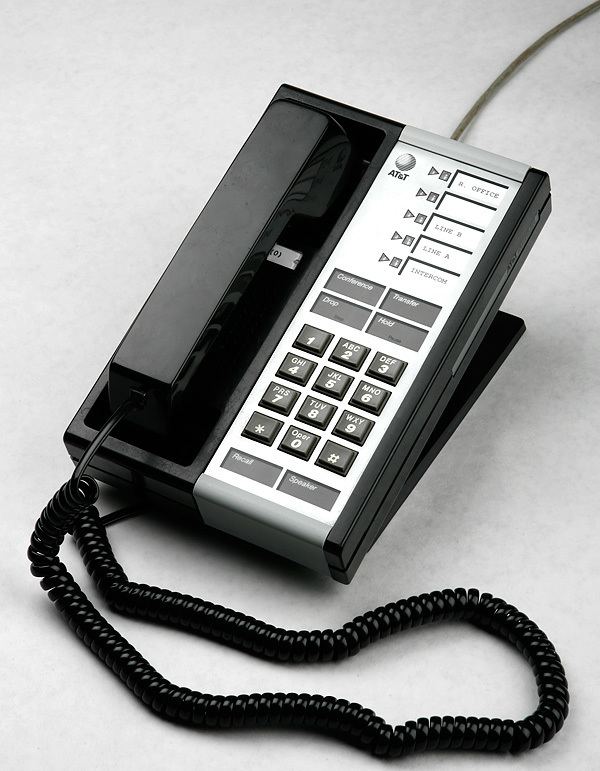 | ||
The AT&T (also Lucent, now Avaya) Merlin telephone system was introduced in late 1983, branded American Bell Merlin. After the breakup of AT&T in 1984, it was rebranded AT&T Merlin. It was designed at the beginning of the 1980s prior to the Bell System Divestiture as a modern electronic replacement for the dated electromechanical 1A2 Key System. Earlier Bell attempts at an electronic key system, such as the Horizon and Dimension, were not as successful as were the much larger systems, in fact the Dimension was a PBX. The Merlin was the first small electronic system, replacing the Com Key 416. The Merlin system was originally sold in two-line, six-telephone (206); four-line, 10-telephone (410); and eight-line, 20-telephone (820) configurations. Later, there was a further 10-line, 30-telephone configuration, with an expansion KSU allowing the system to accommodate up to 70 telephones available (1030 and 3070 respectively).
Contents
Predecessors
The 1A2 Key Telephone System and later ComKey series (4-16, 7-18, 14-34) had the following problems which the Merlin System sought to solve:
History
The Merlin System fixed these problems by:
The original Merlin was replaced with the Merlin Plus system in the late 1980s, using circuit cards to be expandable to 8 lines and 20 telephones, much like the original 820 model. The original Merlin Plus was dubbed the 820d. It was identical in features to the earlier Merlin 820 with the Feature Package 2 cartridge installed. Following the 820d was the 820d2. The 820d2 included the previous features as the 820d but featured an Automatic System Access (ASA) processor coupled with a voice synthesis capabilities and a Busy Buster. The ASA processor provided users with call forwarding, direct extension dial, and system answer capabilities. The busy buster allowed users to have the 820d2 automatically retry a busy number every minute for up to 10 minutes and notify the user when the call was connected. Both the ASA and Busy Buster required a their own voice terminal port to function. In the early 1990s, the Merlin II and Merlin Legend debuted with even more features and expandability, and new MLX telephones, but the system was also backwards compatible with the original Merlin telephones.
In 1999, Lucent Technologies introduced the Merlin Magix as the replacement for the Merlin Legend. The Magix's carrier was metal and, as such, modules were not encased inside plastic shells as they were with the Legend. The Merlin Magix supported new 4400 series digital telephones as well as older MLX telephones, but it did not support the old ATL series telephones. One important item with the conversion of Legend to Magix, is how MLX telephones used 2-pair wiring and the newer Magix/4400 series phones only used a single (1) pair. This made the Magix easier to install and more competitive in the marketplace, as most other digital PBX systems only used a single (1) pair to each station/telephone.
Due to declining sales and the introduction of the IP Office product line, Avaya retired the Magix on April 1, 2006.
Despite being over two decades old, the Merlin's modern electronic features and legendary Bell System era quality and durability still make the Classic Merlins very popular telephone systems with small businesses. Merlin sets shared over 50 pieces of plastic with digital telephones of the Dimension PBX as well as membrane switch technology (a first use in AT&T), reducing product introduction costs in 1983.
Cartridge Type I
Feature Package 1 (Available for use in Classic Merlin 206, 410 only):
Feature Package II (Included same features as Feature Package I plus the following)
Cartridge Type II
Music On Hold
Music On Hold/Paging
Cartridge Type III
Power Failure/Extra Alert
